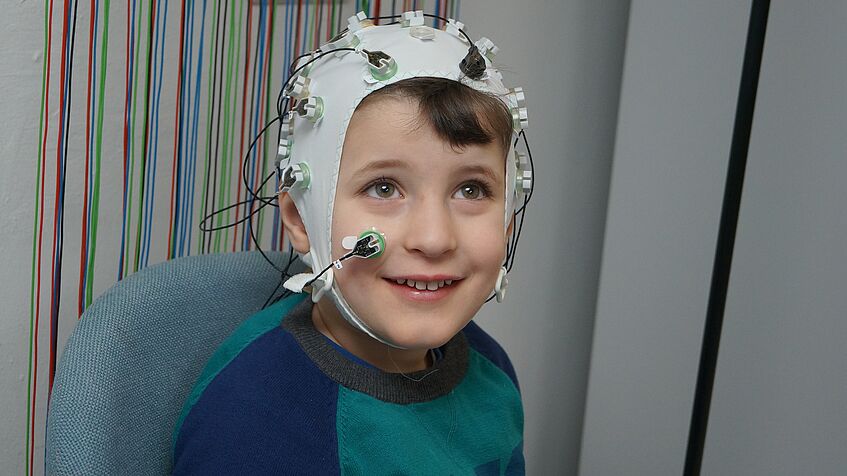Which methods do we use for our studies?

Depending on our research questions in each study, we use various research methods and assessment tools. Of course all our measurement methods are child-friendly, easy to use and do not bear any risks for you or your child. Here, you will find an overview of our methods.
EEG (Electroencephalography)
EEG is a completely safe and painless electrophysiological monitoring method which is applied to record the electrical activity generated by the brain itself. To do this, an elastic cap (similar to a bathing cap) with small flat discs called electrodes, covered with tiny sponges, is placed on the child’s head. These special sensors are used to measure electrical activity generated by the brain (that can be detected on the surface of the head) and send these signals to a computer to record the results (so called ‘brain waves’). This allows us to detect very rapid changes in brain activity and thereby understand mental processes and changes in attention while your child is solving a particular task, looking at images or playing with you.
fNIRS (Functional Near-Infrared Spectroscopy)
fNIRS is another fully safe and non-invasive imaging method for examining activity in the brain. Again, an elastic cap is put on the head of your child, which has so-called optodes (optical sensors) attached to it. Near-infrared light is emitted via the optodes which passes through the skull and upon refraction it gets recorded by other, nearby sensors. As fNIRS only employs non-ionizing light, it does not involve any risk of radiation. By measuring changes in this light, we can detect in which area of the brain oxygen is consumed and thereby draw conclusions about the activation of these brain areas. As fNIRS only uses infrared light and is highly tolerant of participant motion, it is a very suitable method for research with toddlers and babies.
Eye tracking
With eye tracking we can record infants' eye movements and determine where they look on a screen, where they direct their attention to, and how long their gaze remains on one spot. Eye tracking can also be used to measure changes in pupil size. These measurements are carried out with an eye tracker system, which consists of a screen and two small cameras that can record the position of the eyes and the movements they make. This method allows us to understand what a child perceived as particularly interesting, surprising or exciting during a task.
ECG (Electrocardiography)
In ECG testing, heart activity is monitored and recorded on a computer. To do this, we place tiny, flat patches (sensors) onto your child's chest, which can record the heartbeat and can be removed quickly and easily at the end of the session. ECG is a safe and painless test without any risk. The results consist of a visual representation of the heartbeat (cardiac tension curve). The variability in heart rate can provide us with additional information on your child’s activity and emotional state during the session.
Behavioral observation
In many of our studies we record the reactions and behavior of our participants on video camera, e.g. when your child is playing or interacting with you. Later, the videos are evaluated by members of our department using a structured coding system (e.g. coding the duration of the child looking at the mother; the mother looking at the child; mutual gaze; child looking at an object etc.). This method helps us to systematically record and analyse the behavior of our participants during a session in order to better understand the dynamics of social learning and complex social interactions.
